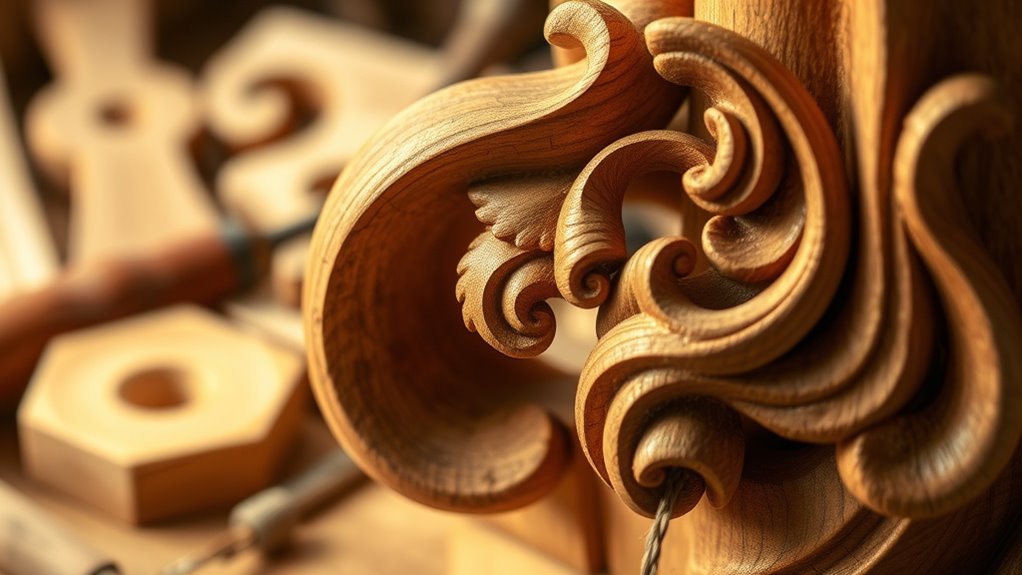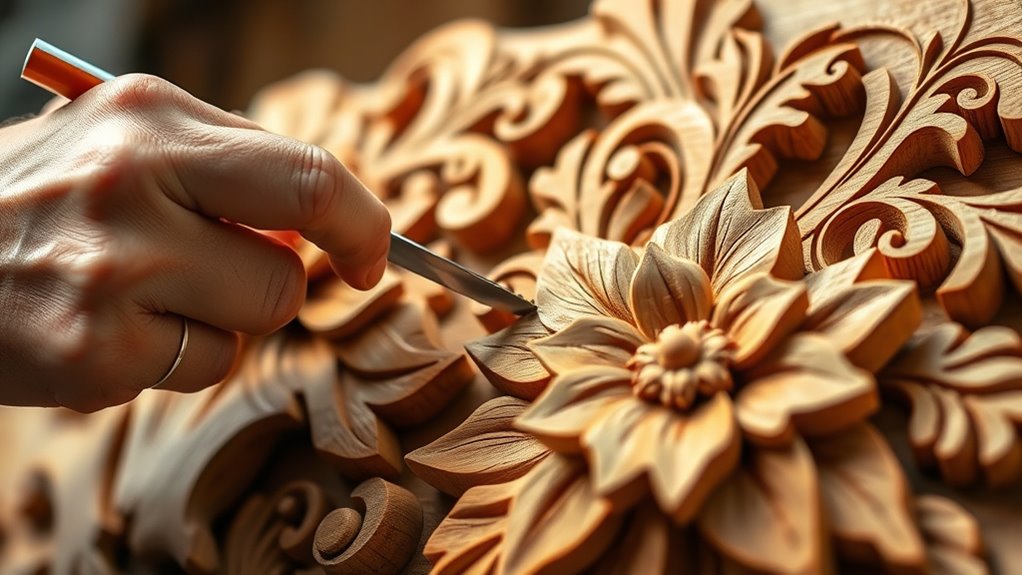Artisanal craftsmanship celebrates the beauty of hand-carved and handmade decor, offering you unique pieces rich in cultural heritage and craftsmanship. These items showcase intricate details, durability, and the skills passed through generations, creating a deep connection to traditions and places. They are sustainably sourced and crafted with natural materials, reflecting a commitment to environmental care. Embracing artisanal decor allows you to bring meaningful, authentic touches into your space—discover more about these timeless treasures below.
Key Takeaways
- Artisanal craftsmanship emphasizes detailed, skillful handwork that reflects cultural heritage and authentic storytelling.
- Hand-carved and handmade decor showcase intricate details, superior durability, and a personal touch from artisans.
- Supporting artisanal practices helps preserve traditional techniques, local customs, and cultural identities.
- These decor pieces prioritize sustainability through natural materials and eco-friendly practices, promoting environmental conservation.
- Living with artisanal decor encourages mindful consumption, celebrates human skill, and fosters a connection to cultural heritage.

Have you ever wondered what makes artisanal craftsmanship so special? It’s the attention to detail, the skill passed down through generations, and the deep respect for tradition that set handcrafted pieces apart from mass-produced items. When you choose artisanal decor, you’re not just getting a beautiful object; you’re embracing a story rooted in cultural heritage. These artisans often rely on sustainable sourcing, guaranteeing that materials are gathered responsibly, protecting the environment and supporting local communities. This commitment to sustainability isn’t just a trend—it’s a core principle that guarantees the longevity of both the craft and the land it depends on. By prioritizing eco-friendly practices, artisans reduce waste, avoid harmful chemicals, and preserve natural resources, making each piece a conscious choice for environmentally aware consumers.
The beauty of handcrafted decor lies in its authenticity. Each piece is a reflection of the artisan’s skills, cultural background, and personal touch. Unlike factory-made items, these creations carry a sense of history and identity, connecting you to a specific place or tradition. For example, carved wooden sculptures may embody centuries-old techniques, while textiles woven with natural dyes tell stories of local customs. When you invest in these pieces, you’re supporting not only individual artisans but also the preservation of their cultural heritage. This keeps traditions alive in a rapidly changing world, fostering a sense of continuity and respect for the past.
Additionally, Cultural Intelligence helps artisans and consumers alike appreciate and navigate the diverse traditions and practices involved in artisanal crafts, enriching the experience and understanding of cultural heritage.
Artisanal craftsmanship also emphasizes the importance of quality over quantity. Because each item is handmade, it often features intricate details and superior durability that mass-produced objects can’t match. This level of craftsmanship requires patience, skill, and a true passion for the work. As a result, your decor becomes more than just decorative; it’s a piece of art that can be treasured for generations. The process of creating these items often involves natural materials like clay, wood, or fiber, sourced sustainably to minimize environmental impact. This mindful approach ensures that your decor is both beautiful and responsible, aligning with values that respect the planet and its cultures.
Choosing artisanal decor means embracing a more intentional way of living. It’s about valuing the stories behind each piece, understanding the effort involved in its creation, and recognizing the importance of sustainable sourcing. These handcrafted objects serve as meaningful accents in your space, reminding you of the rich cultural heritage they represent. In a world dominated by mass production, artisanal craftsmanship stands out as a testimony to the enduring power of human skill, tradition, and environmental consciousness.
Frequently Asked Questions
How Long Does It Typically Take to Craft Handmade Decor Pieces?
It typically takes anywhere from several hours to a few days to craft handmade decor pieces, depending on the complexity and craftsmanship process involved. You’ll find that the time investment varies with each project, as artisans pay close attention to detail and quality. This careful process guarantees that every piece is unique and beautifully crafted, making your decor truly special and worth the wait.
Are Artisanal Crafts More Durable Than Machine-Made Items?
Artisanal crafts often stand out in durability compared to machine-made items, thanks to artisanal durability and handcrafted longevity. You’ll find that skilled artisans meticulously select materials, pay close attention to detail, and apply traditional techniques, resulting in decor that ages gracefully. While machine-made products may be more uniform, handcrafted pieces offer resilience and character that can last a lifetime, making them a worthwhile investment for beauty and lasting quality.
What Are Common Materials Used in Hand-Carved Decor?
You’ll find a rich material variety in hand-carved decor, including wood, stone, bone, and ivory. Each material requires specific crafting techniques, like chiseling, carving, or engraving, which showcase the artisan’s skill. Wood is popular for its versatility and warmth, while stone offers durability and elegance. Bone and ivory add intricate detail, highlighting the craftsmanship. Your choice depends on the desired look, feel, and cultural significance of the piece.
How Can I Verify the Authenticity of Artisanal Craftsmanship?
You can verify the authenticity of artisanal craftsmanship by checking for artisan certification and provenance verification. Look for official labels or certificates from recognized organizations, which confirm the piece’s handmade origin. Ask the seller about the item’s history and origin, and request documentation or photos that trace its provenance. These steps help guarantee you’re buying genuine, handcrafted decor made by skilled artisans, not mass-produced imitations.
What Are the Best Practices for Caring for Handmade Decor?
To care for your handmade decor, follow simple care tips like dusting regularly with a soft cloth and avoiding harsh chemicals. Use preservation methods such as keeping pieces out of direct sunlight and in stable environments to prevent fading or warping. Handle your items gently, and if needed, consult specific care instructions from the artisan. This approach helps maintain their beauty and authenticity over time.
Conclusion
So, next time you’re tempted to buy mass-produced decor, remember the charm of artisanal craftsmanship. Sure, those factory-made pieces might save a few bucks, but they lack the soul, character, and a dash of human error that make hand-carved treasures truly special. Why settle for soulless copies when you can own something crafted with passion—and maybe a little bit of rebellion against the cookie-cutter world? Go ahead, indulge in the imperfect beauty of handmade!









